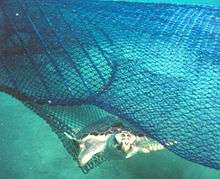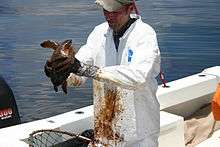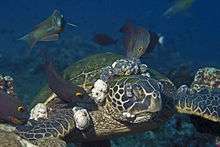Threats to sea turtles

Of the seven extant species of sea turtles, six in the family Cheloniidae and one in the family Dermochelyidae, all are listed on the IUCN Red List of Endangered Species as either "endangered" or "critically endangered".[1] Although sea turtles usually lay around one hundred eggs at a time, on average only one of the eggs from the nest will survive to adulthood.[2] While many of the things that endanger these hatchlings are natural, such as predators including sharks, raccoons, foxes, and seagulls,[3] many new threats to the sea turtle species have recently arrived and increased with the ever-growing presence of humans.[4]
Artificial lighting
One of the greatest threats to the survival of hatchlings is artificial lighting. When a sea turtle hatches, its evolutionary instincts push it to move towards the brightest light in view, which naturally would be the sun or the moon, leading them toward the ocean horizon and into their new ecosystem.[5] However, due to the continual expansion of cities, construction of condos and hotels on coasts everywhere has grown exponentially. With the invention of the light bulb and therefore artificial light, the sea turtle’s natural source of guiding light has been replaced and is no longer the only or the brightest source of light. With virtually every coast now constantly lit with buildings, the hatchlings become easily confused and turned around, few of them making successful treks to the ocean.[6] Studies support artificial light as the leading cause for hatchling disorientation, showing that in 1999, 51% of the nests studied showed signs of confusion with one-fourth of all the hatchlings headed in the wrong direction.[7] As artificial lighting has been shown to be significantly harmful to the offspring of sea turtles, there have been several large-scale conservation efforts by Marine Life programs and conservation groups like that continue to educate the public on turtle conservation. Communities situated on or near a beach have been warned of the effects excessive lighting has on sea turtles and there has been substantial attempts to darken beaches and replace harmful artificial lighting with turtle-safe lights. Some entire communities have adopted official sea turtle protection regulations, such as Florida’s “Lights-out” policy.[8]
Magnetic interference
Ferrous metal wire mesh screens are commonly used to protect sea turtle nests from predators' excavating and devouring the eggs and hatchlings. A new concern is that nestlings' delicate magnetic sense may not develop normally in the presence of the magnetic field interference from these steel mesh cages. The effects of the use of steel mesh as a cage material may not be known for many years until assessments can be made of the success rate of the first adult populations that developed within such cages begin attempting landfall for nest-making. Gravid turtles or their hatchlings may also be affected by the presence of magnetic fields arising from power cables, iron debris, steel seawalls or other human activities that locally modify earth's magnetic field.[5]
Oil spills and marine pollution

Marine pollution is both directly harmful to sea turtles as well as indirectly, through the deterioration of their natural habitats. Some of the most dangerous ocean pollutants include toxic metals, PCBs, fertilizers, untreated waste, chemicals, and a variety of petroleum products. Oil spills are particularly dangerous to sea turtles.[9] Although oil does not tend to stick to them as it does to other marine life, sea turtles are still at risk when they surface for air, where oil can get in their eyes, skin, and lungs which can lead to significant health problems. Even if they are not directly in contact with marine pollution, sea turtles can still ingest harmful chemicals through the food they eat. Oil is also a cause for the death of seagrass, which is a large staple in the diet of the green turtle. The diets of the hawksbill sea turtle, loggerhead sea turtle, and Kemp's ridley sea turtle species have also been affected by the oil’s role in the reduction of certain sponges and invertebrates. Extended exposure has been found to deteriorate the health of a sea turtle in general, making it more weak and vulnerable to a variety of other threats.[10] According to the Sea Turtle Conservancy, formerly known as the Caribbean Conservation Program, the migration habits of sea turtles increase their exposure to marine pollution at each of the stages of their lives including eggs, hatchlings, juveniles, sub adults, or nesting adults. A 1994 study off of Florida’s Atlantic coast, 63% of hatchlings surveyed had been found to have ingested tar. Loggerheads in particular have been shown to have the most problems with tarball ingestion, leading to esophageal swelling that can dislocate the intestines and liver leading to serious buoyancy issues as well as excessive swelling.[9] Many regions heavily associated with oil, either exploration, transportation, or processing, are also significant sea turtle environments, including the Gulf of Mexico and the Caribbean, and particularly the coasts of Texas and Florida.[10] Sea turtles existing in the exact areas where oil spills occur are not the only ones at risk due to the strong and far reaching ocean currents which can move pollution to great distances from its derivation.[11] Breeding season is in particular a dangerous time for sea turtles due to the pollution of beach nesting sites.[12] Contamination of their diet can lead to disruption of digestion as well as physical injury of the sea turtles’ digestive tracts. The nesting of female sea turtles is often deterred due to the potential of oily effluence.[9] If the female does lay eggs, the development of the eggs is still at risk due to either oil in the sand or contamination from the mother turtle that was oiled while nesting. If the eggs in the nest have contact with oil while in the last half of their incubation phase, the rate of hatchling survival sharply decreases and those that do survive have a greater chance of physical deformities.[13]
Ocean plastic
Discarded plastic bags floating in the ocean resemble jellyfish, a common food of sea turtles. If a turtle eats a plastic foil, it tends to clog the turtle's digestive system and results in the animal dying. There have been many cases of dissection showing plastic foil and other debris inside turtles stomachs and intestines.[14]
Tourism
Owing to the popularity of numerous sea turtle species, people often travel to areas where the turtles nest or live to observe and photograph them. This has resulted in numerous deaths of the turtles through boat collisions, tourists attempting to catch or steal individuals, and other incidents. In Costa Rica, tourists have recently been criticised for interfering with the nesting habits of the resident Olive ridley sea turtles, disrupting and confusing the animals by attempting to take selfies with them.[15]
Fishing
According to an article in AAAS & Science, over 8 million sea turtles have died over the past twenty years due to injuries caused by being accidentally caught by fishing boats.[16] Fisheries often use large-scale nets and hook systems that are indiscriminate and catch whatever comes along, be it sea turtle, dolphin, or even shark. What is known as “bycatch” is a large contributor to sea turtle deaths, as seen in Baja California.[16] Longline, trawl,[17] and gillnet fishing are three types of fishing with the most sea turtle accidents. Deaths occur often because of drowning, where the sea turtle was ensnared and could not come up for air.[18] Another dangerous aspect of fishing that is common is when sea turtles inadvertently swallow sharp hooks, which can get stuck within the soft tissue of the throat and stomach, or damage vital organs and intestines.[19]
Poaching
In many countries sea turtles are captured, killed, and traded for their meat, shells and for their leather flippers. Eggs are also at risk of poaching and are commonly eaten by humans and are considered a delicacy in certain cultures. Other cultures believe sea turtle eggs to be aphrodisiacs, while others claim that eating them yields longevity.[20] In some islands, parts of the sea turtle are used in ceremonies and are considered sacred. Other times, the carcasses harvested are made into jewelry, instruments, souvenirs, sunglasses, or wall decorations, especially of the Hawksbill variety which are desired for the striking details of the shell.[21]
Global warming
Although climate change is estimated to have more serious effects on wildlife over the next few decades, there is evidence that sea turtles have already been affected. With the increase of temperature, polar ice has melted and has led to the rise of sea levels. This rise in sea levels has been a factor in the loss of beach, which for sea turtles means less nesting area. Global warming has been associated with severe weather, which could mean harsh and numerous storms that erode beaches and flood nests.[22] As the overall temperature of the earth rises, so does the temperature of the sand, which diminishes the rate of hatchling survival. The temperature of the sand also affects gender, as higher temperatures have been shown to yield more female hatchlings. Changes in climate also influence currents and change the number and location of prey species. Water that is too warm can also cause coral bleaching, which is detrimental to reefs that are essential to certain species, such as the Hawksbill sea turtle.[23]
Disease

A disease known as fibropapillomatosis manifests itself in turtles through external tumors. These tumors often grow to be so large that they hinder a sea turtle’s ability to see, eat, and swim, therefore rendering the sea turtle unable to survive. Inexplicably, the majority of the cases of fibropapillomatosis have been diagnosed in the green sea turtle (Chelonia mydas) while none have been in the leatherback sea turtle (Dermochelys coriacea). Cases of this disease have been found in all major oceans. Although the causes of this disease are not clear, many believe the source to be viral. These tumors are either smooth or contain pointed projections and they are red, pink, grey, black, or purple in color. These tumors are usually located anywhere on the soft skin tissue of the sea turtle, either the neck, eyes, or bottom of the flippers and range in size anywhere from a pea to a grapefruit.[24]
Conservation efforts and rehabilitation centers
A study by Discovery News targets the Mediterranean, the Eastern Pacific, the Southwest Atlantic, and the Northwest Atlantic as the regions in the direst need of preservation endeavors. In 1963, the Marine Turtle Group was created by the chairman of the Survival Service Commission of the International Union for the Conservation of Nature and Natural Resources as the first international forum for sea turtle research and conservation.[25] In 1973, the Endangered Species Act was passed, providing protection for all sea turtle species, and in 1977, a Memorandum of Understanding was signed between the NOAA Fisheries and the U.S. Fish and Wildlife Service to enforce the ESA with regards to sea turtles. USFWS is responsible for all sea turtle conservation on nesting beaches and NOAA Fisheries are responsible for the marine conservation of sea turtles. The conservation of sea turtles on an international scale has been led by two major environmental agreements: the Indian Ocean – South-East Asian Marine Turtle Memorandum of Understanding and the Inter-American Convention for the Protection and Conservation of Sea Turtles.[26] In an attempt to lessen the number of turtles killed by fishing incidents, several new types of turtle-safe fishing equipment have been introduced such as the circle hooks,[27] fish bait, and turtle excluder devices.[28] Poaching has been outlawed in most countries and turtle conservation education has been growing in both in size and efficiency.
Rehabilitation centers have been established as well, such as the Marine Life Center in Juno Beach, Florida [29] and the Karen Beasley Sea Turtle Rescue and Rehabilitation Center located on Topsail Island, North Carolina.[30] The purpose of these centers is to help protect the local and endangered sea turtle population by: a) rescuing sick or injured turtles and taking them to the treatment facility, b) rehabilitating these turtles through various types of treatment and/or surgery, and c) releasing turtles back into the ocean once they have been successfully nursed back to health. Although some sea turtles’ injuries are so severe that they can never become healed to the extent of being able to survive on their own outside of the facilities, hundreds of the patients from both the Gordon and Patricia Gray Veterinary Hospital in Juno Beach and the Sea Turtle Hospital in Topsail Island have been successfully rehabilitated and released in the last couple of decades.
Evaluating the progress of conservation programs is difficult, because many sea turtle populations have not been assessed adequately.[31] Most information on sea turtle populations comes from counting nests on beaches, but this doesn’t provide an accurate picture of the whole sea turtle population.[32] A 2010 United States National Research Council report concluded that more detailed information on sea turtles’ life cycles, such as birth rates and mortality, is needed.[33]
See also
- Memorandum of Understanding concerning Conservation Measures for Marine Turtles of the Atlantic Coast of Africa
- Memorandum of Understanding on the Conservation and Management of Marine Turtles and their Habitats of the Indian Ocean and South-East Asia
References
- ↑ IUCN 2010. IUCN Red List of Threatened Species. Version 2010.4. <http://www.iucnredlist.org>. 8 December 2010
- ↑ Wright, Sara. "Hilton Head Island sees record sea turtle nesting season." Bluffton Today (2010): n. pag. Web. 8 Dec 2010. <http://www.blufftontoday.com/news/2010-08-06/hilton-head-island-sees-record-sea-turtle-nesting-season>.
- ↑ "Natural ." Sea Turtle Foundation. Sea Turtle Foundation, 2010. Web. 8 Dec 2010. <http://www.seaturtlefoundation.org/threats/natural/>.
- ↑ Heithaus, Michael, Aaron Wirsing, Jordan Thomson, and Derek Burkholder. "A review of lethal and non-lethal effects of predators on adult marine turtles." Journal of Experimental Marine Biology and Ecology 356.1-2 (2008): 43-51. Web. 15 Dec 2010.
- 1 2 Lohmann, Catherine, and Kenneth Lohmann. "Sea turtles ." Current Biology 16.18 (2006): R784-R786. Web. 15 Dec 2010.
- ↑ Carvajal, Marc. "The Biogeography of Leatherback Turtles." San Francisco State University. San Francisco State University, Nov 2002. Web. 8 Dec 2010. <http://bss.sfsu.edu/holzman/courses/fall02%20projects/leatherback.htm>.
- ↑ Nicholas, Mark. "Light Pollution and Marine Turtle Hatchlings: The Straw that Breaks the Camel's Back?." The George Wright Forum. The George Wright Society, 2001. Web. 8 Dec 2010.
- ↑ Lindsay, Fredrica. "Saving Sea Turtles with a Lights-Out Policy in Florida." National Geographic News10 Mar. 2003: n. pag. Web. 8 Dec 2010.
- 1 2 3 "Sea Turtle Threats: Oil Spills." Sea Turtle Conservancy (2010): n. pag. Web. 8 Dec 2010. <http://www.conserveturtles.org/seaturtleinformation.php?page=oilspills>.
- 1 2 Milton, Sarah, and Peter Lutz. United States. Oil and Sea Turtles Biology, Planning, and Response. 2010. Web. 8 Dec 2010.
- ↑ Witherington, B.E. "Ecology of neonate loggerhead turtles inhabiting lines of downwelling near a Gulf Stream front." Sea Turtle Conservancy (2002): n. pag. Web. 8 Dec 2010.
- ↑ Antworth, Rebecca, David Pike, and John Stiner. "Nesting ecology, current status, and conservation of sea turtles on an uninhabited beach in Florida, USA." Biological Conservation 130.1 (2006): 10-15. Web. 15 Dec 2010.
- ↑ United States. Impacts of Oil on Marine Mammals and Sea Turtles. , 2010. Web. 8 Dec 2010.
- ↑ Pictures of plastic items eaten by turtles
- ↑ http://www.cbc.ca/news/trending/selfie-taking-tourists-threaten-sea-turtle-population-in-costa-rica-1.3237329
- 1 2 Stokstad, Erik. "Sea Turtles Suffer Collateral Damage From Fishing." Science AAAS 07 Apr 2010: n. pag. Web. 8 Dec 2010.
- ↑ Sasso, Christopher, and Sheryan Epperly. "Seasonal sea turtle mortality risk from forced submergence in bottom trawls." Fisheries Research 81.1 (2006): 86-88. Web. 15 Dec 2010.
- ↑ Haas, Heather, Erin LaCasella, Robin LeRoux, Henry Miliken, and Brett Hayward. "Characteristics of sea turtles incidentally captured in the U.S. Atlantic sea scallop dredge fishery." Fisheries Research 93.3 (2008): 289-295. Web. 15 Dec 2010.
- ↑ Viegas, Jennifer. "Millions of Sea Turtles Captured, Killed by Fisheries." Discovery News (2010): n. pag. Web. 8 Dec 2010.
- ↑ Butler, Rhett. "Sex sells sea turtle conservation in Mexico." Environmental News August 19, 2005: n. pag. Web. 9 Dec 2010. <http://news.mongabay.com/2005/0819-turtles.html>.
- ↑ Le Guern Lytle, Claire. "Sea Turtle Egg Poaching Legalized in Costa Rica: The Debate ." Coastal Care. N.p., n.d. Web. 9 Dec 2010. <http://coastalcare.org/2011/07/legalized-poaching-turtles-eggs-and-playa-ostional-costa-rica/>.
- ↑ "Global Warming." SEE Turtles. N.p., 2007. Web. 9 Dec 2010. <http://www.seeturtles.org/1380/global-warming.html>.
- ↑ Markey, Sean. "Global Warming Has Devastating Effect on Coral Reefs, Study Shows." National Geographic News 28 Oct 2010: n. pag. Web. 9 Dec 2010. <http://news.nationalgeographic.com/news/2006/05/warming-coral.html>.
- ↑ Florida. Fibropapillomatosis and its effect on green turtles. , 2010. Web. 8 Dec 2010.
- ↑ Davis, Frederick. "Saving sea turtles: the evolution of the IUCN Marine Turtle Group." Endeavour 29.3 (2005): 114-118. Web. 15 Dec 2010.
- ↑ "Marine Turtles." Office of Protected Resources. NOAA Fisheries, 11 Nov 2010. Web. 8 Dec 2010. <http://www.nmfs.noaa.gov/pr/species/turtles/>.
- ↑ Read, Andrew. "Do circle hooks reduce the mortality of sea turtles in pelagic longlines? A review of recent experiments." Biological Conservation 135.2 (2007): 155-169. Web. 15 Dec 2010.
- ↑ "Bycatch - So what's the answer?." WWF Global. N.p., 2009. Web. 9 Dec 2010. <http://www.smartgear.org/smartgear_bycatch/bycatch_
- ↑ "Our Mission." Loggerhead Marinelife Center. N.p., 2010. Web. 9 Dec 2010. <http://www.marinelife.org/mission>.
- ↑ "The Karen Beasley Sea Turtle Rescue and Rehabilitation Center Mission Statement." Topsail Turtle Project. N.p., 2011. Web. 4 Oct 2011. <http://seaturtlehospital.org/whoweare.htm>.
- ↑ Bjorndal, Karen; Bowen, Brian; Chaloupka, M.; Crowder, L. B.; Heppell, S. S.; Jones, C. M.; Lutcavage, M. E.; Policansky, D.; et al. (2011). "Better Science Needed for Restoration in the Gulf of Mexico" (PDF). Science. AAAS. 331 (6017): 537–538. doi:10.1126/science.1199935. PMID 21292956. Retrieved July 25, 2011.
- ↑ Witherington, B.E.; Kubilis, Anne; Brost, Beth; Meylan, Anne (2009). "Decreasing annual nest counts in a globally important loggerhead sea turtle population". Ecological Applications. Ecological Society of America. 19 (1): 30–54. doi:10.1890/08-0434.1. PMID 19323172.
- ↑ The National Research Council (2010). "Assessment of Sea Turtle Status and Trends: Integrating Demography and Abundance". Washington, DC: National Academies Press
